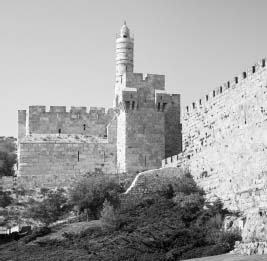JudaismMembership, Community, Diversity |
Why is Jerusalem Judaism’s holiest city? Are any others especially important? |
Jerusalem was the last of several places that functioned as seats of power during the early years of Judaism’s monarchy. Around the year 1000 B.C.E., King David captured the hilltop stronghold from a Canaanite tribe called the Jebusites. David’s choice of location may well have been motivated by a desire to establish himself politically in a city that had few links to premonarchical Jewish factions. Jerusalem, also called the Hill of Zion, promised David a fresh start. Situated on the highest point in the region (some 2500 feet above sea level), and more or less in the center of tribal territories, the city already had great physical and topographical potential for acquiring symbolic power. But it would be Solomon’s Temple, not David’s royal headquarters, that would confer on Jerusalem the mantle of great holiness.
Within a few generations after David, the city had become the focal point not only of major Jewish ritual and pilgrimage, but the very throne of God. Messianic hopes and expectations came to be attached to Jerusalem. After the Babylonian Exile the prospect of restoring the city to its former glory gave rise to a new theological interpretation. No longer a mere earthly city, Jerusalem was also—and even more importantly—a heavenly reality mirrored in a terrestrial one.
For many centuries after the Romans destroyed the Second Temple in 70 C.E., Jerusalem was a source of longing for Jews scattered across the globe. As Jews began to return in significant numbers, especially after 1492, Jerusalem became concretely important to the people again. The proclamation of the State of Israel in 1948 raised hopes further, and with Israel’s recapture of the city in the Six-Day War of 1967, many Jews revived plans for a full restoration of Jerusalem. For some now that means plans to rebuild the Temple, but the political implications are so enormous as to make that a most unlikely eventuality. Virtually every square foot of the “Holy Land” bears some historic meaning. Places that had been especially holy in the days of the Patriarchs and Judges (prior to the monarchy) have retained only a shadow of their pristine sacredness. Nothing compares with Jerusalem in that regard.

The Tower of David in Jerusalem is believed to be located on the site of King David’s palace.
